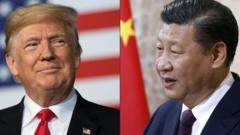The ongoing trade dispute between the US and China intensifies as both nations exhibit reluctance to make the first move towards negotiations, despite rising economic pressures.
**US-China Trade Tensions: Will Either Side Compromise?**

**US-China Trade Tensions: Will Either Side Compromise?**
As trade negotiations hang in the balance, both nations grapple with escalating costs and economic repercussions.
In a significant development on Friday, China's Ministry of Commerce revealed it is considering potential tariff negotiations with the United States, a revelation eagerly awaited given the staggering tariffs of up to 245% imposed on certain Chinese goods. The situation is escalating tensions between the two largest economies in the world, underlining fears of a possible recession.
According to the spokesperson, the US has shown a willingness to negotiate, but China insists that the US should demonstrate sincerity and retract its unilateral tariffs first. This cryptic stance was mirrored by a recent post from a Weibo account connected to state media, suggesting that the US is currently more eager for talks. "China has no need to talk to the United States," read the post.
As rhetoric heats up, experts liken the situation to a 'game of chicken,' where both President Trump and President Xi Jinping are reluctant to appear weak. As Ja Ian Chong, a political science expert at the National University of Singapore points out, both parties want to avoid being the first to concede but recognize that de-escalation would benefit both.
The current deadlock is characterized by an ongoing cycle of declarations and rejections, and experts highlight a 'constructive ambiguity' in communication—where vague statements allow both sides to maintain their narrative. This tactic has led some analysts to speculate that the Chinese government might be attempting to craft a path for a mutual disengagement from the escalating trade conflict.
Should mediation be introduced by an external party, it could offer a possible escape route from this standoff. Experts suggest that each side needs to interpret outreach in a manner that allows them to retain the appearance of strength during negotiations.
Moreover, it is crucial to consider the domestic pressures facing both leaders. Trump aims to project a narrative of US superiority in negotiations, while Xi needs to show his own people that he can manage and counteract the impact of the trade war.
Success for either leader hinges on navigating the balance of international leadership and domestic approval. As trade continues to dwindle, it is hurting both Chinese exporters and American consumers, painting a dire picture of the current situation. The urgency for a resolution grows, but with both sides hesitant to move, it remains uncertain who will show the willingness to compromise first.
At the time of reporting, there are indications that both sides are in communication, but whether this will lead to substantive discussions or remain a standoff remains to be seen.
According to the spokesperson, the US has shown a willingness to negotiate, but China insists that the US should demonstrate sincerity and retract its unilateral tariffs first. This cryptic stance was mirrored by a recent post from a Weibo account connected to state media, suggesting that the US is currently more eager for talks. "China has no need to talk to the United States," read the post.
As rhetoric heats up, experts liken the situation to a 'game of chicken,' where both President Trump and President Xi Jinping are reluctant to appear weak. As Ja Ian Chong, a political science expert at the National University of Singapore points out, both parties want to avoid being the first to concede but recognize that de-escalation would benefit both.
The current deadlock is characterized by an ongoing cycle of declarations and rejections, and experts highlight a 'constructive ambiguity' in communication—where vague statements allow both sides to maintain their narrative. This tactic has led some analysts to speculate that the Chinese government might be attempting to craft a path for a mutual disengagement from the escalating trade conflict.
Should mediation be introduced by an external party, it could offer a possible escape route from this standoff. Experts suggest that each side needs to interpret outreach in a manner that allows them to retain the appearance of strength during negotiations.
Moreover, it is crucial to consider the domestic pressures facing both leaders. Trump aims to project a narrative of US superiority in negotiations, while Xi needs to show his own people that he can manage and counteract the impact of the trade war.
Success for either leader hinges on navigating the balance of international leadership and domestic approval. As trade continues to dwindle, it is hurting both Chinese exporters and American consumers, painting a dire picture of the current situation. The urgency for a resolution grows, but with both sides hesitant to move, it remains uncertain who will show the willingness to compromise first.
At the time of reporting, there are indications that both sides are in communication, but whether this will lead to substantive discussions or remain a standoff remains to be seen.


















